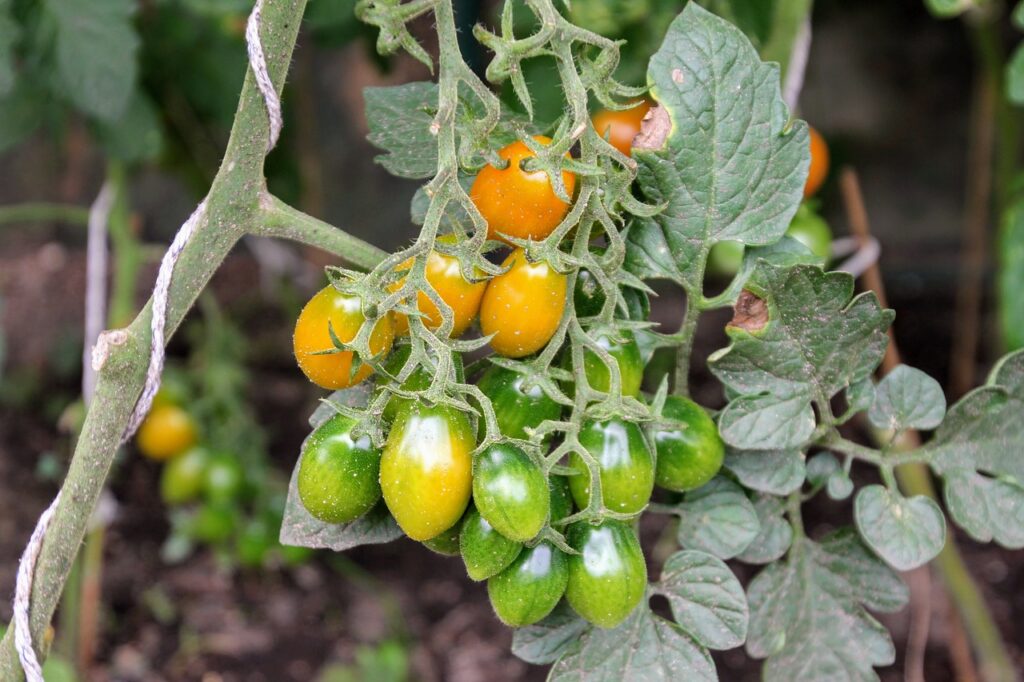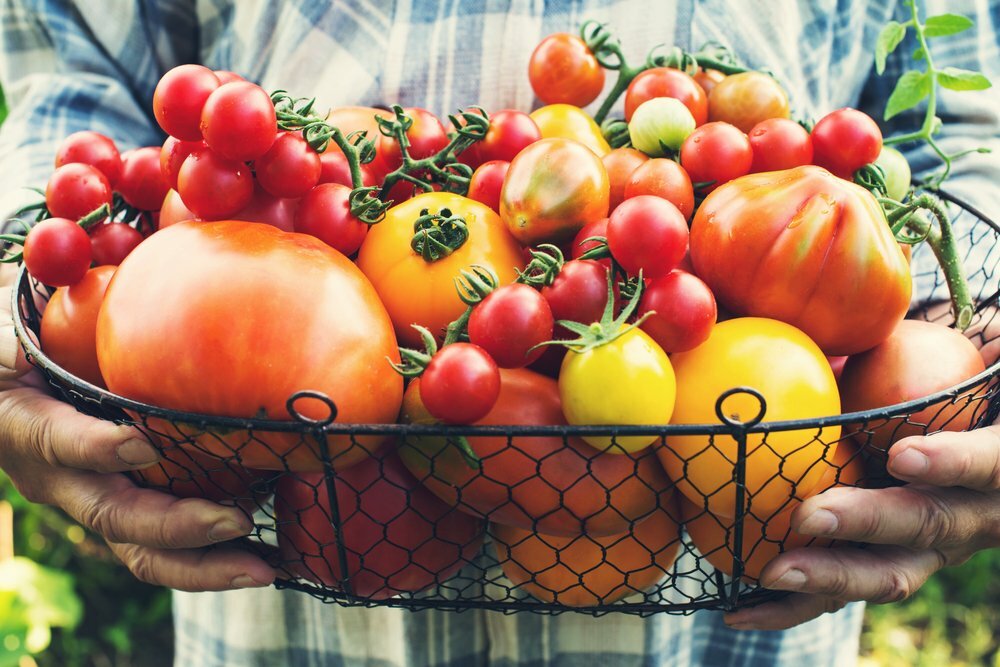In this Article
Tomatoes are one of the most beloved culinary fruits in the gardening community and it’s not surprising that they are so popular, as their flavour and versatility have long been celebrated in kitchens the world over.
Yet, there’s a lot to consider when growing your own tomatoes. You’ll want to think about watering, mulching, soil quality, fertilising, and numerous other factors. For the purpose of this article though, we’re going to focus on fertilising tomato plants.
Now if you’re already planning your spring garden, chances are, you’re probably wondering when to start feeding your tomato plants. Today, let’s talk about the various types of fertiliser and when to use them.

Why You Should Feed Your Tomato Plants
Tomatoes put a lot of work into producing delicious fruit for us. To help them along on their journey, it’s a good idea to give them a well-balanced diet. In doing so, not only will your tomato plants grow stronger and healthier overall, but you’ll gain a much more robust harvest.
Key Essential Nutrients Include:
Nitrogen (N) is vital for adequate plant growth at all stages of development and will contribute toward increasing your tomato harvest.
Phosphorus (P) is crucial for root expansion, tissue development, and helps your tomato plant make use of water more efficiently. It also enables optimal nutrient uptake and regulates metabolic processes within the plant. For this reason, phosphorus is an essential plant nutrient that will improve your tomato plant’s productivity. You may need to add more phosphorus if you notice that your tomato plant is failing to thrive and grow.
Potassium (K) regulates the water absorption and the plant’s ionic balance. This tomato nutrient also helps tomatoes turn red and ripen, as it is directly responsible for lycopene production. Lycopene is an organic pigment and carotenoid that helps tomatoes ripen and turn red.

5 Natural Ways to Feed Your Tomato Plants
There are a few different ways to feed your tomato plants. Natural fertiliser is often the best option for long-term soil and plant health. However, synthetic fertilisers can also be useful for remedying immediate issues. Whichever you choose to use, your local garden supplier should have an excellent selection. Here are some natural fertilisers to consider.
Compost
Compost material is considered to be an organic method of feeding your plants. To apply compost fertiliser in a planter, simply spread 4 inches of compost over your growing area. Then mix the compost into your yard soil to make it more fertile. If using patio pots, simply mix the compost into your potting soil before planting.
Fish Emulsion
This natural liquid fertiliser comes from fish waste. It comes with high levels of nitrogen as well as other trace minerals like calcium and magnesium. It is particularly smelly and potent, so you’ll want to dilute it in water before application. If applied without dilution, your tomato plants may suffer chemical scalding.
Animal Manure
This naturally rich fertiliser needs to be aged before application. The perfect place to do this, of course, is in a compost pile. In this way, the manure will be mixed in with other waste material. Manure is high in all three essential nutrients: nitrogen, Phosphorus, and potassium.
Bone and Blood Meal
These fertilisers are sold as mix-in powders and can be added to your potting soil from the start. Both bone meal and blood meal are high in nitrogen and phosphorus, plus they tend to release nutrients over time.
Epsom Salts
Epson salt (Magnesium Sulphate) is a soil additive that provides sulfur and magnesium. These minerals in turn, enable your tomato plants to produce chlorophyll and uptake other nutrients like phosphorus and nitrogen. Essentially, Epson salts help your tomato plants stay healthy and produce verdant foliage.
Tomatoes require plenty of nitrogen for leafy growth, phosphorus for flowering and fruit production, and potassium to regulate photosynthesis. Furthermore, tomatoes also benefit from receiving micro and macro nutrients like calcium, iron, magnesium, boron, and zinc as micro and macro nutrients.
There are various varieties of tomato fertiliser on the market; which one will work best in your garden depends on your preferences.

When to Start Feeding Your Tomato Plants
The easiest rule of thumb to know when to feed your tomato plants is planning to fertilise them about every 4 to 6 weeks. If using a synthetic fertiliser pay attention to the NPK analysis ratio to determine which fertiliser to purchase.
Additionally, potted tomato plants may have a higher need for regular feeding, due to limited space and soil access. A liquid fertiliser with the ratio 5-5-5 or 5-10-5 can be applied bimonthly during watering. In other words, a liquid fertiliser with the ratio of 5-10-5 simply means that 5% of the solution is nitrogen, 10% is phosphorus, and 5% is potassium. The remaining 80% is comprised of other less important nutrients.
When you do go to feed your tomato plants, be sure to do so late in the afternoon, when heat from the sun has long been waning. Even better, do so on a cloudy day and/or just before rainfall is expected in the forecast. Also, apply liquid fertiliser at the base of the plant, just as you do when watering, to reduce the risk of powdery mildew.
Feeding Your New Sprouts
Your new tomato seedlings put in a lot of effort to sprout, and they will be hungry! You can begin to feed your tomato sprouts a water-soluble fertiliser a few days after they have germinated above the soil and have begun to grow their true leaves. The fertiliser should be rich in phosphorus. Continue to feed seedlings weekly until they are ready to be transplanted outside. An NPK ratio of 12-24-12 and also 8-32-16 is ideal for seedlings. Always be sure to dilute your liquid fertiliser with water before application.
Feeding Your Seedlings at Planting Time
When you set out to finally plant your tomato plants in the ground or in large patio pots, be sure to choose a water-based fertiliser high in phosphorus. A fertiliser with an NPK ratio of 20-10-10 is appropriate at this stage.
Feeding Young Plants Before Flowering
In order to encourage and support the flowering stage, use an NPK ratio of 5-15-5. Apply this fertiliser about two weeks prior to when your particular variety is due to start blooming. This mixture is especially high in phosphorus, which tomato plants need in order to grow prolific flowers.
Feeding Your Tomato Plants During the First Fruiting
Once your tomato plant begins to set fruit, you may want to apply a 5-10-5 type fertiliser to help it along. These are the special liquid tomato feeds what are available in the shops like the well know brand Tomorite. These fertilisers are high in potash which helps the tomatoes to set the flowers and grow better fruits.
Feeding After Your First Fruit Harvest
For indeterminant tomato plant varieties that continue to set fruit all season, you’ll want to feed them after the initial fruit harvest. This will help replenish lost nutrients and keep the plant going strong.
Keeping your tomatoes happy and healthy is really important but also super easy. Sometimes the hardest part of learning something new is simply getting started. Once you’ve fertilised your tomato plants a few times, it will feel like second nature. Simply follow the instructions we’ve outlined above, and you’ll be all set.

